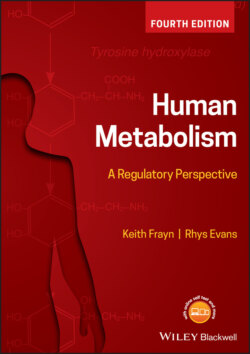Читать книгу Human Metabolism - Keith N. Frayn - Страница 34
1.3.2.1.1 Glucose phosphorylation
ОглавлениеFollowing uptake into the cell by glucose transporters, the first step of glucose metabolism within cells is always phosphorylation to glucose 6-phosphate (G6-P), brought about by a member of a family of enzymes (hexokinases) that use ATP, again expressed in a tissue-specific manner. The form expressed in liver and pancreatic β-cells, hexokinase Type IV, is generally known as glucokinase; that expressed in skeletal muscle, Type II, is generally known simply as hexokinase. Phosphorylation ensures that the molecule does not diffuse again out of the cell, locking it into the cell, maintaining its inward concentration (and augmenting further glucose influx), and activating the molecule for further metabolism. G6-P is used by glycolysis (glucose breakdown, next section) and glycogen synthesis as well as the pentose phosphate pathway (Section 1.3.2.1.7 below); it may also be derived from glycogen breakdown (glycogenolysis) and gluconeogenesis (glucose synthesis: Section 1.3.2.1.5 below) depending on tissue and prevailing metabolic state. Thus, G6-P may be seen as lying at a major crossroads in carbohydrate metabolism (Figure 1.14).
